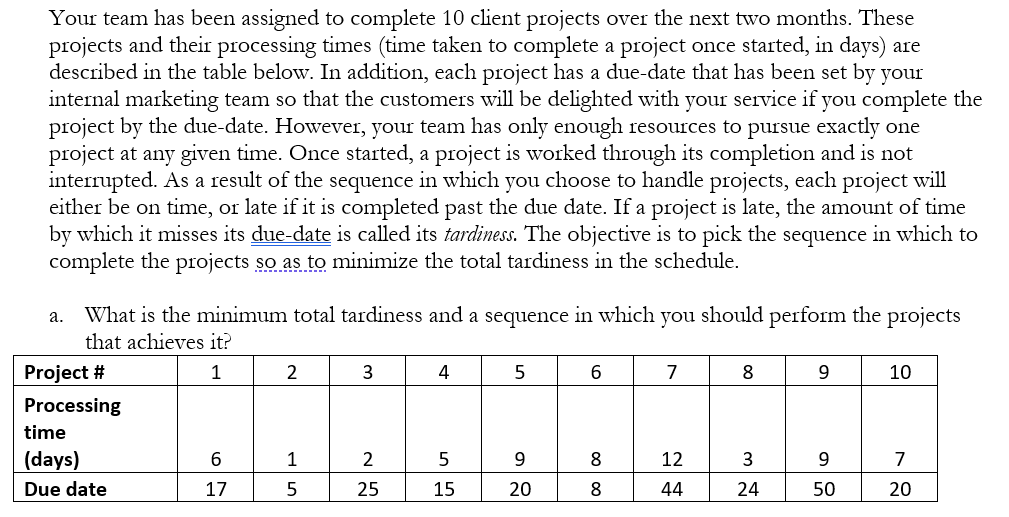Your team has been assigned to complete 10 client projects over the next two months. These projects and their processing times (time taken to complete a project once started, in days) are described in the table below. In addition, each project has a due-date that has been set by your internal marketing team so that the customers will be delighted with your service if you complete the project by the due-date. However, your team has only enough resources to pursue exactly one project at any given time. Once started, a project is worked through its completion and is not interrupted. As a result of the sequence in which you choose to handle projects, each project will either be on time, or late if it is completed past the due date. If a project is late, the amount of time by which it misses its due-date is called its tardiness. The objective is to pick the sequence in which to complete the projects so as to minimize the total tardiness in the schedule. What is the minimum total tardiness and a sequence in which you should perform the projects that achieves it? a. Project # 1 2 4 7 8 10 Processing time (days) 6 1 5 12 3 7 Due date 17 25 15 20 8 44 24 50 20
Your team has been assigned to complete 10 client projects over the next two months. These projects and their processing times (time taken to complete a project once started, in days) are described in the table below. In addition, each project has a due-date that has been set by your internal marketing team so that the customers will be delighted with your service if you complete the project by the due-date. However, your team has only enough resources to pursue exactly one project at any given time. Once started, a project is worked through its completion and is not interrupted. As a result of the sequence in which you choose to handle projects, each project will either be on time, or late if it is completed past the due date. If a project is late, the amount of time by which it misses its due-date is called its tardiness. The objective is to pick the sequence in which to complete the projects so as to minimize the total tardiness in the schedule. What is the minimum total tardiness and a sequence in which you should perform the projects that achieves it? a. Project # 1 2 4 7 8 10 Processing time (days) 6 1 5 12 3 7 Due date 17 25 15 20 8 44 24 50 20
Practical Management Science
6th Edition
ISBN:9781337406659
Author:WINSTON, Wayne L.
Publisher:WINSTON, Wayne L.
Chapter12: Queueing Models
Section: Chapter Questions
Problem 59P
Related questions
Question

Transcribed Image Text:Your team has been assigned to complete 10 client projects over the next two months. These
projects and their processing times (time taken to complete a project once started, in days) are
described in the table below. In addition, each project has a due-date that has been set by your
internal marketing team so that the customers will be delighted with your service if you complete the
project by the due-date. However, your team has only enough resources to pursue exactly one
project at any given time. Once started, a project is worked through its completion and is not
interrupted. As a result of the sequence in which you choose to handle projects, each project will
either be on time, or late if it is completed past the due date. If a project is late, the amount of time
by which it misses its due-date is called its tardiness. The objective is to pick the sequence in which to
complete the projects so as to minimize the total tardiness in the schedule.
What is the minimum total tardiness and a sequence in which you should perform the projects
that achieves it?
а.
Project #
1
2
3.
4
5
7
8
9
10
Processing
time
(days)
6
1
2
9
12
3
7
Due date
17
25
15
20
8
44
24
50
20
Expert Solution
This question has been solved!
Explore an expertly crafted, step-by-step solution for a thorough understanding of key concepts.
This is a popular solution!
Trending now
This is a popular solution!
Step by step
Solved in 2 steps with 1 images

Recommended textbooks for you

Practical Management Science
Operations Management
ISBN:
9781337406659
Author:
WINSTON, Wayne L.
Publisher:
Cengage,

Practical Management Science
Operations Management
ISBN:
9781337406659
Author:
WINSTON, Wayne L.
Publisher:
Cengage,